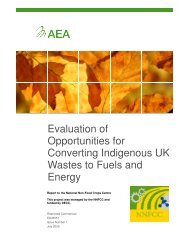Consumption and the environment (SOER2010) - European ...
Consumption and the environment (SOER2010) - European ...
Consumption and the environment (SOER2010) - European ...
Create successful ePaper yourself
Turn your PDF publications into a flip-book with our unique Google optimized e-Paper software.
Thematic assessment | <strong>Consumption</strong> <strong>and</strong> <strong>the</strong> <strong>environment</strong><br />
8 Concluding reflections: consumption,<br />
<strong>environment</strong>al priorities <strong>and</strong> policies<br />
The SOER 2010 syn<strong>the</strong>sis (EEA, 2010a) identifies four<br />
future <strong>environment</strong>al priorities in Europe to address <strong>the</strong><br />
identified links between risks <strong>and</strong> increased uncertainties<br />
across <strong>the</strong> world:<br />
• implementing <strong>and</strong> streng<strong>the</strong>ning current<br />
<strong>environment</strong>al policies;<br />
• dedicated management of natural capital <strong>and</strong><br />
ecosystem services;<br />
• coherent integration of <strong>environment</strong>al considerations<br />
across <strong>the</strong> many policy domains; <strong>and</strong><br />
• a greening of <strong>the</strong> economy.<br />
This chapter takes, as its starting point, <strong>the</strong>se four<br />
priorities <strong>and</strong> provides a perspective on <strong>the</strong> role of<br />
consumption within <strong>the</strong>m. It does so by using <strong>the</strong> analyses<br />
of <strong>the</strong> previous chapters to discuss options <strong>and</strong> potential<br />
obstacles.<br />
Finally, <strong>the</strong> chapter considers that public authorities<br />
at <strong>the</strong> EU, national <strong>and</strong> local levels are responsible for<br />
deciding on <strong>and</strong> implementing a policy framework<br />
<strong>and</strong> policy instruments. However, <strong>the</strong>y cannot ensure<br />
more <strong>environment</strong>ally sustainable consumption<br />
without business <strong>and</strong> citizens playing an active <strong>and</strong><br />
complementary role in a triangle of change (Figure 8.1).<br />
8.1 <strong>Consumption</strong> <strong>and</strong> current<br />
<strong>environment</strong>al policies<br />
A broad range of policies, <strong>environment</strong>‐related or not,<br />
set <strong>the</strong> framework for consumption patterns, including,<br />
for example, <strong>the</strong> EU Common Agricultural Policy<br />
(CAP), EU transport policies, <strong>the</strong> Cohesion Policy, <strong>and</strong><br />
trade policies. All <strong>the</strong>se influence <strong>the</strong> relative prices <strong>and</strong><br />
availability of different goods <strong>and</strong> services.<br />
The focus of EU <strong>environment</strong>al policies on sustainable<br />
consumption <strong>and</strong> production has gradually evolved over<br />
recent decades from a focus mainly on cleaner production,<br />
through sustainable products to a more holistic approach<br />
to sustainable consumption <strong>and</strong> production.<br />
The overall EU policy framework dedicated to addressing<br />
<strong>the</strong> <strong>environment</strong>al impacts of consumption is <strong>the</strong> EU<br />
Action Plan on Sustainable <strong>Consumption</strong> <strong>and</strong> Production<br />
<strong>and</strong> Sustainable Industrial Policy (EC, 2008a). It seeks<br />
to improve <strong>the</strong> supply, <strong>and</strong> stimulate dem<strong>and</strong> for,<br />
sustainable products <strong>and</strong> services. This includes <strong>the</strong><br />
streng<strong>the</strong>ning <strong>and</strong> extension of <strong>the</strong> Eco‐design Directive,<br />
<strong>the</strong> EU Eco‐label <strong>and</strong> Energy Label Directives, <strong>and</strong> Green<br />
Public Procurement (Box 8.1). The EU Action Plan thus<br />
mainly makes use of regulatory, information‐based <strong>and</strong><br />
voluntary instruments.<br />
At <strong>the</strong> national level, at least 15 EU Member States have<br />
adopted national SCP strategies ei<strong>the</strong>r as st<strong>and</strong>‐alone<br />
overarching SCP strategies or action plans — <strong>the</strong> Czech<br />
Republic, Finl<strong>and</strong>, Pol<strong>and</strong> <strong>and</strong> <strong>the</strong> United Kingdom — or<br />
as a key <strong>the</strong>me within national sustainable development<br />
strategies — Austria, Belgium, Denmark, Finl<strong>and</strong>,<br />
France, Hungary, Italy, Malta, <strong>the</strong> Ne<strong>the</strong>rl<strong>and</strong>s, Romania<br />
<strong>and</strong> Sweden (EEA, 2010; Watson et al., 2009 <strong>and</strong> Adell<br />
et al., 2009). There is a great potential in sharing good<br />
practices from <strong>the</strong> design <strong>and</strong> implementation of such<br />
policies.<br />
Policies in <strong>the</strong> EU <strong>and</strong> in individual EEA member<br />
countries have, in most cases, focused on products, by<br />
promoting <strong>the</strong> supply of more sustainable products <strong>and</strong><br />
encouraging consumers to buy <strong>the</strong>se through <strong>the</strong> use of<br />
labelling or o<strong>the</strong>r information‐based instruments (Berg,<br />
2007; Tukker et al., 2008; Rubik et al., 2009). In addition,<br />
at national <strong>and</strong> local levels, economic instruments are<br />
increasingly being used particularly for influencing<br />
energy <strong>and</strong> water consumption, mobility behaviour <strong>and</strong><br />
waste (Table 8.1).<br />
Research shows that policy implementation using a single<br />
type of instrument alone often has limited impact. Using a<br />
complementary mix of various types of policy instruments<br />
addressing different groups of actors is likely to increase<br />
<strong>the</strong> effectiveness of policy implementation in <strong>the</strong> field<br />
of SCP (OECD, 2010; Rubik et al., 2009; Jackson, 2005;<br />
Jackson <strong>and</strong> Michaelis, 2003).<br />
Labelling has, in a few cases, proved effective, for<br />
instance in <strong>the</strong> case of electrical appliances for which<br />
energy efficiency labels have helped drive significant<br />
improvements over <strong>the</strong> past decade. In addition,<br />
well‐designed consumer campaigns can help raise<br />
awareness <strong>and</strong> contribute to influencing behaviour,<br />
especially if campaigns are linked to o<strong>the</strong>r instruments<br />
<strong>and</strong> particularly in areas where awareness levels are low.<br />
A recent OECD study found that in addition to <strong>the</strong> key<br />
The <strong>European</strong> <strong>environment</strong> | State <strong>and</strong> outlook 2010<br />
45








